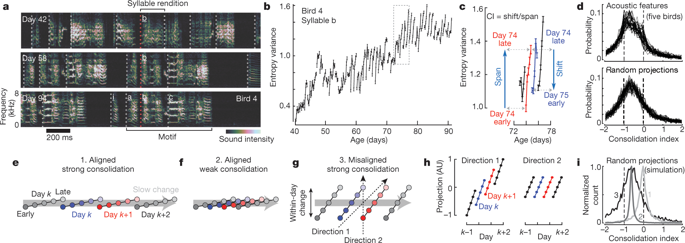Nature ( IF 64.8 ) Pub Date : 2020-01-08 , DOI: 10.1038/s41586-019-1892-x Sepp Kollmorgen 1 , Richard H R Hahnloser 1 , Valerio Mante 1

|
Changes in behaviour resulting from environmental influences, development and learning1,2,3,4,5 are commonly quantified on the basis of a few hand-picked features2,3,4,6,7 (for example, the average pitch of acoustic vocalizations3), assuming discrete classes of behaviours (such as distinct vocal syllables)2,3,8,9,10. However, such methods generalize poorly across different behaviours and model systems and may miss important components of change. Here we present a more-general account of behavioural change that is based on nearest-neighbour statistics11,12,13, and apply it to song development in a songbird, the zebra finch3. First, we introduce the concept of ‘repertoire dating’, whereby each rendition of a behaviour (for example, each vocalization) is assigned a repertoire time, reflecting when similar renditions were typical in the behavioural repertoire. Repertoire time isolates the components of vocal variability that are congruent with long-term changes due to vocal learning and development, and stratifies the behavioural repertoire into ‘regressions’, ‘anticipations’ and ‘typical renditions’. Second, we obtain a holistic, yet low-dimensional, description of vocal change in terms of a stratified ‘behavioural trajectory’, revealing numerous previously unrecognized components of behavioural change on fast and slow timescales, as well as distinct patterns of overnight consolidation1,2,4,14,15 across the behavioral repertoire. We find that diurnal changes in regressions undergo only weak consolidation, whereas anticipations and typical renditions consolidate fully. Because of its generality, our nonparametric description of how behaviour evolves relative to itself—rather than to a potentially arbitrary, experimenter-defined goal2,3,14,16—appears well suited for comparing learning and change across behaviours and species17,18, as well as biological and artificial systems5.
中文翻译:

最近的邻居揭示了运动学习的快速和慢速部分
由环境影响、发展和学习1、2、3、4、5引起的行为变化通常根据一些精心挑选的特征2、3、4、6、7(例如,声学发声3),假设行为的离散类别(如不同的声乐音节)2,3,8,9,10。然而,这些方法在不同的行为和模型系统中的泛化能力很差,并且可能会遗漏重要的变化组成部分。在这里,我们提出了一个基于最近邻统计11、12、13的行为变化的更一般的描述,并将其应用于鸣禽斑胸草雀的歌曲发展3. 首先,我们引入了“曲目约会”的概念,即为行为的每次演绎(例如,每次发声)分配一个曲目时间,反映行为曲目中类似的演绎何时是典型的。曲目时间分离出与声音学习和发展引起的长期变化一致的声音变异成分,并将行为曲目分层为“回归”、“预期”和“典型演绎”。其次,我们根据分层的“行为轨迹”获得了对声音变化的整体但低维的描述,揭示了快速和慢速时间尺度上行为变化的许多以前未被识别的组成部分,以及隔夜巩固的不同模式1, 2,4,14,15 贯穿整个行为曲目。我们发现回归中的日变化仅经历弱巩固,而预期和典型再现则完全巩固。由于其普遍性,我们对行为如何相对于自身演变的非参数描述——而不是潜在的任意的、实验者定义的目标2、3、14、16——似乎非常适合比较行为和物种之间的学习和变化17,18,以及生物和人工系统5。



























 京公网安备 11010802027423号
京公网安备 11010802027423号